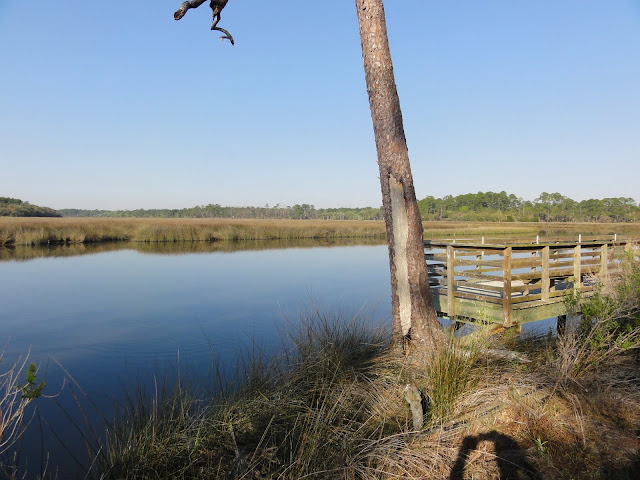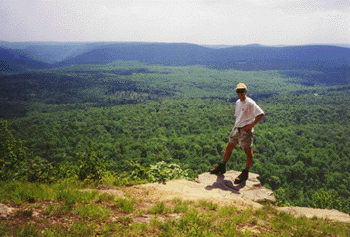OK, time for list number 2. Most of my major dreams for backpacking trips
involve the western US, now that I have hiked the entire AT. But there are a number of shorter trips in the Appalachians that I would like to do at some point as well. Many of these are weekend or 4-5 day affairs, or could be extended given the time.
I would actually consider hiking the entire AT at once sometime in the future. If I ever do it, I would probably start around the first of May and aim to finish by the end of August, maybe mid-September. This would prevent hiking in iffy weather and late snows in the south and would maximize appreciation of the rhododendrons in May-June. It would also allow me to finish before early wintery weather is likely in Maine. It would be a fairly ambitious pace - roughly 500 miles per month, 125 per week.
I have also included some favorite sections of the A.T. that I would like to repeat with friends or family as shorter trips. Once again, I am not ranking them in order.
1.
Laurel Highlands Trail. This is a ~70 mile route through the Laurel Highlands region in southwestern PA. It's one of our favorite places - we were camping in Ohiopyle when we got engaged, and we have skied and hiked in the area a few other times. This route has regular shelters, and I envision it would be good for a first long trip for Calista . . so a few years down the road, and only if she takes to backpacking!
2. Repeat
Presidential range on the AT. The ~30 miles of trail between Crawford Notch and Pinkham Notch in New Hampshire's White Mountains include over 15 continuous miles above treeline. It's one of the most spectacular and memorable sections of the 2175-mile trail. I am interested in hiking the Presidentials as an extreme day hike (one can start north of Madison Hut and make it around 25 miles, I think). For backpacking, given the time, I would add the next section south to Franconia Notch, which would include Mount Lincoln and Lafayette; and possibly the Carter-Wildcat range to the north as well. I have also been thinking about hiking part of all of this route from hut-to-hut, staying at the high-elevation enclosed
primitive lodges that are maintained by the AMC. Accommodations are a bit pricey, but would make a memorable family trip.
3.
Green Ridge State Forest/C&O loop (MD). This is a a~40-45 mile loop that could be done in 3 days and is close to home - the trailhead is less than 2 hours away. Half of the route is along a traditional hiking trail in
MD state forest land, and the rest follows the C&O Canal towpath along the Potomac River through rugged and undeveloped mountain terrain. The canal route includes a trip through the Paw Paw tunnel.
4.
Foothills Trail (SC). This route follows a route in the
high-elevation portion of South Carolina, near the NC border. It's a good 5-7 day route (76 miles), and gets good reviews for waterfalls and solitude. The trail passes through
Table Rock State Park, which is said to offer outstanding views.
5.
section of the
Mountains-to-Sea Trail (NC). This trail is a work-in-progress that will eventually span
1000 miles west-to-east in North Carolina, from Clingmans Dome in the Smokies to the ocean. I think it would be fun to do a week-long section on the mountainous western end of the trail.
6.
Florida Trail through Ocala or Appalachicola. The
Florida National Scenic Trail starts in Big Cypress National Preserve, just north of the Everglades, and winds it's way through forest remnants along the middle of the state, then turns west to trail the panhandle region. Including alternate and side routes there are around 1000 miles of trail in the system. Some hikers start in Big Cypress (or even in Key West, hiking initially along US route 1) and make their way through connecting routes in Alabama to the AT, then north to Maine. I am not that ambitious, but I would like to do the ~70 mile section in Ocala National Forest, which lies just north of Orlando. This segment has some wilderness character and would be a fun March (spring break) excursion. Another option would be to hike in Appalachacola National Forest, in the panhandle region.
7.
Repeat
Roan Mnt to I-81 (AT). One of my favorite sections of the AT included the areas around
Roan Mountain, the Grayson Highlands, and the
Smokies. Given enough time, I would hike from Fontana Dam through the Smokies, over Roan and Rogers again. A one-week trip could start (or end) at Roan Mnt and hike north to Mt. Rogers and beyond. A good end point would be the Settlers Museum, just a few miles from I-81.
8.
Repeat
Long Mnt. Wayside to Rockfish Gap (AT). We
day-hiked this segment over a couple of days, and it included some beautiful views and grassy ridges. I would love to explore them again, especially in May-June or in the fall. A good opportunity for a long weekend or a 5-day trip.
9.
Allegheny Trail (WV). This
330-mile trail runs north-south through West Virginia, starting near Pearisburg on the AT and ending north of Canaan Valley - one of our favorite places. It's much less-used than the AT or other eastern trails, and would provide good opportunity for solitude. At this point I am interested in any length trip along this trail, whether a weekend or a full week. A portion of this trail is part of the route for the
Great Eastern Trail, a long-distance route that parallels the AT further west. It includes the Sheltowee Trace in Kentucky, the Cumberland Trail in Tennessee, the Pinhoti Trail in Alabama, and the Tuscarora Trail in VA/PA, and in total extends from Alabama to NY.
10.
Northville-Lake Placid trail. This would be another good week-long excursion, running
north-south through the Adirondacks. We have skied a portion of it in the south. There are shelters along the route. It would also be interesting to connect this route to the High Peaks region and summit one or two of the high peaks there at the end of the trip.
Also worth mentioning:
Tuscarora Trail - this ~
250 mile trail was envisioned in the 1960's, before the National Trails System act provided federal protection for the AT corridor. Hikers were concerned that the AT route through northern VA and MD would become over-run with development, so they designed this alternate route as a "back-up". It now provides an interesting alternate route, starting near Overall Run Falls in northern Shenandoah and re-joining the AT near Harrisburg, PA. The Potomac Appalachian Trail Club is working in building shelters along the route, with a goal of achieving similar coverage to the AT - shelters every 10 miles or so along the entire route. I have hiked ~60 miles of this trail, mostly at the southern end. It would not be too difficult to use day-hikes and weekend trips to complete the trail without a long-distance backpacking trip.
Pennsylvania trails - there are many little-explored routes in north-central PA, some of which I hiked with the Wilmington Trail Club when I lived in Delaware. There is much more to explore, along the Mid-State Trail, Susqhehannock Trail, and a long section of the 3000+ mile North Country Trail.
Southern Appalachians - with thousands of acres of National Forest land, the southern Appalachian region is covered with trails, for myriad hiking options. I could probably do a long hike here every summer and never leave the region. Other designated trails include the Bartram Trail and the Benton McKaye trail.
Other AT sections - some other favorite portions of the AT that I would like to re-visit include the New Jersey section; Nantahala National Forest (NC); Green Mountains (Vermont - also part of the Long Trail, on my other top 10 list); and most of Maine (given how rugged it is, I can't believe I am including this section - but it truly was beautiful).
 s in this event every season - and we have won the championship for the past three years. As the event approached last week, the weather forecast continued to worsen. A storm that dumped 16 inches of snow on the Front Range in Colorado was headed our way. On the morning of the race, the temperatures hovered in the upper 30s and a cold rain had been falling all night. The course, covering a mixture of grass and dirt trails, was in awful shape. Two features of the course were particularly problematic this year. The course features a crossing of a ~20 yard wide creek, which is normally ~6 inches deep at the most. Swollen with the rain, the water was turbid, obscuring the bottom, and reached several feet in depth. In addition, a downed tree forced a detour on another section of the course, resulting in a steep descent on what soon turned into a very muddy hill.
s in this event every season - and we have won the championship for the past three years. As the event approached last week, the weather forecast continued to worsen. A storm that dumped 16 inches of snow on the Front Range in Colorado was headed our way. On the morning of the race, the temperatures hovered in the upper 30s and a cold rain had been falling all night. The course, covering a mixture of grass and dirt trails, was in awful shape. Two features of the course were particularly problematic this year. The course features a crossing of a ~20 yard wide creek, which is normally ~6 inches deep at the most. Swollen with the rain, the water was turbid, obscuring the bottom, and reached several feet in depth. In addition, a downed tree forced a detour on another section of the course, resulting in a steep descent on what soon turned into a very muddy hill. These were the worst conditions I have seen in 16 years of coaching. Several of my assistant coaches, with an additional 40+ years of experience, agreed with this assessment. I have run in below-zero temperatures with snow on the ground (MIAA championships in college) and in many other instance in the rain and mud. The New Castle County Championships had to be postponed one year after the first couple of races because the course was too dangerous. The Prep Classic in 2009 faced a similar situation. But Saturday, Oct 29th will go down in my memory as the most brutal conditions to date.
These were the worst conditions I have seen in 16 years of coaching. Several of my assistant coaches, with an additional 40+ years of experience, agreed with this assessment. I have run in below-zero temperatures with snow on the ground (MIAA championships in college) and in many other instance in the rain and mud. The New Castle County Championships had to be postponed one year after the first couple of races because the course was too dangerous. The Prep Classic in 2009 faced a similar situation. But Saturday, Oct 29th will go down in my memory as the most brutal conditions to date.



















